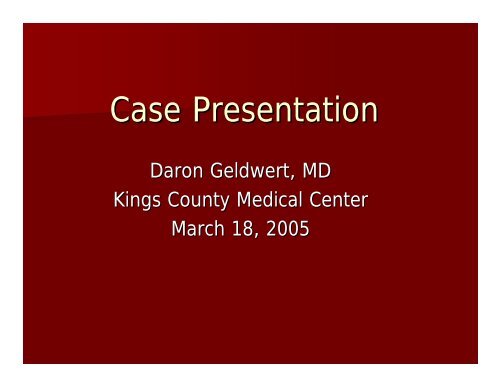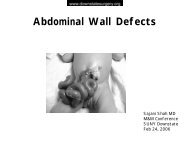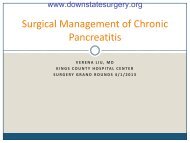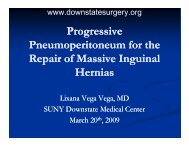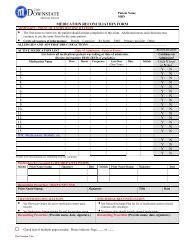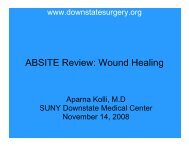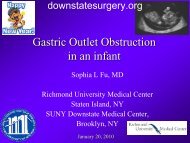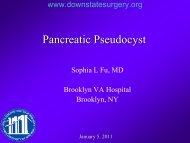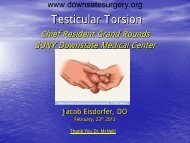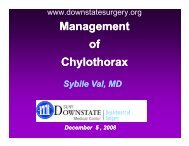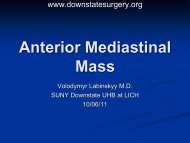Case Presentation - Department of Surgery at SUNY Downstate ...
Case Presentation - Department of Surgery at SUNY Downstate ...
Case Presentation - Department of Surgery at SUNY Downstate ...
You also want an ePaper? Increase the reach of your titles
YUMPU automatically turns print PDFs into web optimized ePapers that Google loves.
<strong>Case</strong> <strong>Present<strong>at</strong>ion</strong>Daron Geldwert, MDKings County Medical CenterMarch 18, 2005
Gastrointestinal Stromal Tumors: AMolecular and Surgical Approach
Wh<strong>at</strong> is GIST?•
Historical Evolution• 1940’s- l<strong>at</strong>e 1960’s- Defined as smooth muscleneoplasm• 1970’s- EM showed th<strong>at</strong> only a few <strong>of</strong> thesetumors has smooth muscle differenti<strong>at</strong>ion• 1983- Mazur and Clark coined the neutral term‘Gastric Stromal Tumor’ after revealing th<strong>at</strong>many SMT lacked the immunohistochemical orEM evidence <strong>of</strong> smooth muscle.(Mazur M, Clarke H Am J Surg P<strong>at</strong>h, 1983)
Where do these tumor cellsorigin<strong>at</strong>e from?• Origin<strong>at</strong>e from stem cells th<strong>at</strong> differenti<strong>at</strong>etowards the interstitial cells <strong>of</strong> Cajal (ICC).• ICC arise from precursor mesenchymal cells th<strong>at</strong>intercal<strong>at</strong>e between nerve fibers and musclecells in the adult intestine acting as pacemakercells <strong>of</strong> the GIT, with regul<strong>at</strong>ion <strong>of</strong> peristalsis.• Both ICC and GIST express KIT protein andhave similar ultrastructural fe<strong>at</strong>ures.(Kindblom,, LG et al. Am J P<strong>at</strong>h, 1998).• Not all GISTs arise from ICC, as some comefrom the mesentery or omentum which lackICCs, , suggesting an origin in multipotentialmesenchymal stem cells.
ICC
C-KIT: A Defining Marker• KIT, a 145-KD transmembrane glycoprotein, is theproduct <strong>of</strong> the c-kit c(CD117) proto-oncogene.oncogene.• A member <strong>of</strong> the tyrosine kinase receptor.• The kit receptor can be detected by IHC staining forCD117, a cell surface antigen on the extracellulardomain <strong>of</strong> the KIT receptor.• Stem-cell factor (SCF), also known as Steel factor (SLF),is the ligand for Kit.• Binding <strong>of</strong> SLF to Kit results in receptor homo-dimeriz<strong>at</strong>ion, activ<strong>at</strong>ion <strong>of</strong> KIT tyrosine kinase activity,and resultant phosphoryl<strong>at</strong>ion <strong>of</strong> a variety <strong>of</strong> substr<strong>at</strong>esth<strong>at</strong> serve as effectors <strong>of</strong> intracellular signaltransduction.• This activ<strong>at</strong>ion <strong>of</strong> signal transduction p<strong>at</strong>hways leads tocellular growth and prolifer<strong>at</strong>ion.
KIT and its rel<strong>at</strong>ionship to GIST• Hirota et al investig<strong>at</strong>ed the mut<strong>at</strong>ional st<strong>at</strong>us <strong>of</strong> c-kit cinmesenchymal tumors <strong>of</strong> the GI tract.• They examined 49 mesenchymal tumors th<strong>at</strong> werediagnosed as gastrointestinal stromal tumors.• 94% (46/49) <strong>of</strong> these expressed KIT.• 82% (40/49) CD34-positive• 78% (38/49) positive for both KIT and CD34• Demonstr<strong>at</strong>ed th<strong>at</strong> ICC were positive for kit and CD 34.• They also demonstr<strong>at</strong>ed th<strong>at</strong> mut<strong>at</strong>ions <strong>of</strong> c-kit cresultedin gain <strong>of</strong> function <strong>of</strong> the enzym<strong>at</strong>ic activity <strong>of</strong> the KITtyrosine kinase.• These mut<strong>at</strong>ions result in:– Auto-phosphoryl<strong>at</strong>ion <strong>of</strong> c-kit c– Ligand-independent independent tyrosine kinase activity– Stimul<strong>at</strong>ion <strong>of</strong> downstream signaling p<strong>at</strong>hwaysleading to uncontrolled cell prolifer<strong>at</strong>ion.
Clinical <strong>Present<strong>at</strong>ion</strong>• Occur in middle ages and older persons.• Range in size from millimeters to 40 cm.• Average tumor size <strong>at</strong> diagnosis 8cm.• Often asymptom<strong>at</strong>ic and discovered incidentally.• Commonest present<strong>at</strong>ion is palpable abdominalmass (50-70%), GI bleeding (30%), andabdominal pain (20%).• Abdominal fullness, obstruction or perfor<strong>at</strong>ion.• 30% metast<strong>at</strong>ic or locally infiltr<strong>at</strong>ing.
Diagnosis• AXR• Endoscopy• CT scan• Percutaneous Biopsy
Gastric GIST
Gastric GIST
Rectal GIST
Histological Characteriz<strong>at</strong>ionSpindle (70%)Epitheloid (30%)
Low Risk versus High Risk
Immunohistochemistry• Essential for the diagnosis.• The distinction between GISTs and othertumors can be difficult by light microscopyalone.
GISTLMSGISTSchwannoma
Immunohistochemistry• 95% c-Kit c(CD 117)• 60-70% CD 34• 20-30% SMA• 5% S-100S• 1-2% Desmin
Predictors <strong>of</strong> Behavior• Size• Mitotic r<strong>at</strong>e• Loc<strong>at</strong>ion• Incomplete Surgical Resection• Tumor Rupture
Prognostic FactorsBucher, P et al. Swiss Med Wkly, 2004.
Disease Specific Survival AfterComplete ResectionDeM<strong>at</strong>eo, , R et al. Ann Surg, , 2000
Tre<strong>at</strong>ment Options• <strong>Surgery</strong>• Radi<strong>at</strong>ion/Chemotherapy• Tyrosine Kinase Inhibitors
<strong>Surgery</strong>• Only tre<strong>at</strong>ment option th<strong>at</strong> can definitively curethe disease.• Standard initial tre<strong>at</strong>ment for non-metast<strong>at</strong>icdisease.• Excise en-bloc, avoid tumor spillage.• Lymphadenectomy not indic<strong>at</strong>ed.• 5 year survival in multiple studies noted to be48%-65% after complete resection.• Median time to recurrence in retrospective studyabout 19 months (Pierie,, JP et al. Arch Surg 2001).
Radi<strong>at</strong>ion/Chemotherapy• Rarely used.• Highly radio-resistant resistant combined with theradio-sensitivity <strong>of</strong> adjacent organs.• Chemotherapy response r<strong>at</strong>es only 10-15% with multiple drug regimens.
HUMAN PATHOLOGY, 2002.
Molecularly Targeted Therapy• Since activ<strong>at</strong>ion <strong>of</strong> Kit plays a crucial role in thep<strong>at</strong>hogenesis <strong>of</strong> GIST, inhibition <strong>of</strong> Kit would betherapeutic.• Im<strong>at</strong>inib (Gleevec)) is a competitive and rel<strong>at</strong>ivelyselective antagonist <strong>of</strong> ATP binding th<strong>at</strong> blocksthe ability <strong>of</strong> c-Kit cto transfer phosph<strong>at</strong>e groupsfrom ATP to tyrosine residues on substr<strong>at</strong>eproteins, which in turn interrupts c-kit cmedi<strong>at</strong>edsignal transduction.
Gleevec
Duffaud et al. Oncology 2003
• http://www.glivec.com/content/gist_video.html
Pro<strong>of</strong> <strong>of</strong> Concept Study• 50 year old female with metast<strong>at</strong>ic GISTdiagnosed in 1996.• Liver metastases and multiple small intra-abdominal metastases were excised in 1998.• Seven cycles <strong>of</strong> chemotherapy with doxorubicin,ifosfamide, and dacarbazine with no response.• In March 1999 had bowel obstruction found <strong>at</strong>laparotomy to have diffuse intra-abdominalabdominalmets.• Received thalidomide and α-interferon with noresponse.• Tre<strong>at</strong>ment with 400 mg Im<strong>at</strong>inib once daily wasstarted in March 2000.Joensuu, , H et al. N. Engl. J. Med., 344: 1052-1056, 1056, 2001
• MRI:Results– 2wks: 41% reduction tumor size– 8Mo: 75% reduction tumor size– 14Mo: >80% reduction tumor size• Biological Response: Needle biopsy livershowed dram<strong>at</strong>ic reduction in Kitpositivity.• FDG-PET scan: 4 weeks
Phase II Trial: Study Design• Assess the clinical activity <strong>of</strong> Gleevec asreflected by objective response r<strong>at</strong>es.• Initi<strong>at</strong>ed July 2000• P<strong>at</strong>ients with un-resectable or metast<strong>at</strong>icGIST were randomized to receive 400 or600 mg <strong>of</strong> Gleevec per day.• 147 p<strong>at</strong>ients enrolled.• CR, PR, stable disease, progressivedisease.
Demetri, , G. et al. NEJM, 2002.
Phase II: Con’d• 86% <strong>of</strong> tumor specimens analyzed (72 p<strong>at</strong>ients)had activ<strong>at</strong>ing mut<strong>at</strong>ions <strong>of</strong> KIT– 71% exon 11– 14% exon 9– 1% exon 17• P<strong>at</strong>ients whose tumor had no detectable KITmut<strong>at</strong>ion were eight times more likely to haveprimary progression in response to Gleevec(44%) compared with p<strong>at</strong>ients whose tumorexpressed an exon 11 activ<strong>at</strong>ing KIT mut<strong>at</strong>ion.• Early registr<strong>at</strong>ion approval from FDA in February2002.
Unanswered Questions?• Wh<strong>at</strong> is the right dose?• Dur<strong>at</strong>ion <strong>of</strong> therapy?• Will neoadjuvant therapy improveoutcome?• Will adjuvant therapy improve outcome?• Influence <strong>of</strong> mut<strong>at</strong>ions on response totherapy?• Role <strong>of</strong> surgery in recurrence?
Southwest Oncology Group(S0033)- Dosage• US Study (Rankin,(Rankin, C et al. Proc AmSoc Clin Oncol, , 2004).– 746 p<strong>at</strong>ients– Response r<strong>at</strong>es 43% for both– Two year progression free 50%LD vs. 53% HD– Two year survival estim<strong>at</strong>es78% LD vs. 73% HD– Higher dose not significantlybetter.• European Study (Verweij(Verweij J. et al.Lancet, 2004).– 946 p<strong>at</strong>ients– RR: 50% LD vs. 54% HD– Two year survival: 69% LD vs.74% HD– Two year progression freesurvival: 44% LD vs. 50% HD
Dur<strong>at</strong>ion <strong>of</strong> Therapy• French Trial in progress th<strong>at</strong> is randomlyassigning p<strong>at</strong>ients with advanced GIST and noevidence <strong>of</strong> progressive disease after one year<strong>of</strong> Gleevec to continuous therapy, or interruption<strong>of</strong> therapy until disease progression.• Until results return continuous therapy adviseduntil disease progression.Blay JY et al. Proc Am Soc Clin Oncol, , 2004.
Adjuvant: Phase II ACSOG Z9000• High Risk– Tumor >10cm– Tumor Rupture– Tumor Hemorrhage– Multifocal Tumors• Must start within 84 days<strong>of</strong> resection.• Continue for 1 year in theabsence <strong>of</strong> recurrence orunacceptable toxicity.
Adjuvant: Phase III ACSOG(Z9001)
Neoadjuvant Therapy• Currently in the formul<strong>at</strong>ive stages.• Single center study <strong>of</strong> 126 pts. <strong>at</strong> MD Andersondeemed 16/17 unresectable tumors resectableafter on average 10 months <strong>of</strong> Gleevec (Scaifeal. Am J Surg, , 2003).• Radiographic Evidence– 4% CR– 35% PR– 37% Stable– 18% Progression– 2% DiedScaife, , C. et
Time to Recurrence• Median time to recurrence is 1.5 to 2 years.• Only 10% who undergo complete surgicalresection are disease free after an averagefollow-up <strong>of</strong> 68 months (MD Anderson d<strong>at</strong>a).• 5-Year Survival is about 50-65% after completeresection <strong>of</strong> localized GIST versus 35% withadvanced disease.• A total <strong>of</strong> 40%-90% surgically resected p<strong>at</strong>ientshave post-op op recurrence or metastasis.• Most recur in the peritoneum and liver.
Influence on Mut<strong>at</strong>ions onRecurrence• Approxim<strong>at</strong>ely 90% <strong>of</strong> allGISTs have a c-Kit cmut<strong>at</strong>ion.• All Kit mutant is<strong>of</strong>orms wereassoci<strong>at</strong>ed with a clinicalresponse:– Exon 11: 84% PR– Exon 9: 48% PR• Time to tre<strong>at</strong>ment failure– Exon 11: 687 days– Exon 9: 200 daysHeinrich, MC et al. J Clin Oncol, , 2003.
Peritoneal Metastasis• Cytoreductive surgery followed by intraperitonialchemotherapy with cispl<strong>at</strong>in and doxorubicin ormitoxantrone for peritoneal recurrence.• In 27 p<strong>at</strong>ients with disease isol<strong>at</strong>ed to theperitoneum, the median time to recurrence wasincreased from 8 months with surgery alone to21 months with the addition <strong>of</strong> intraperitonealmitoxantrone.• Presently, only indic<strong>at</strong>ed for p<strong>at</strong>ients whosetumors are resistant to Gleevec.Eilber, , FC et al. Surg Oncol, , 2000.
Liver Metastasis• 131 p<strong>at</strong>ients <strong>at</strong> MSKCC with liver mets– 34 (26%) underwent complete resection <strong>of</strong> allgross disease.– No peri-oper<strong>at</strong>ive de<strong>at</strong>hs– 1 and 3-yr 3survival were 90% and 58%.– Survival was predicted by the time intervalbetween the resection <strong>of</strong> the primary tumorand the development <strong>of</strong> liver mets.
Liver MetsEisenberg, B. et al. Ann Surg Oncol, , 2004.
Tre<strong>at</strong>ment AlgorithmWu, P et al. <strong>Surgery</strong>, , 2003
Summary• GIST tumors are more common than previouslyobserved.• IHC is essential for the diagnosis.• The applic<strong>at</strong>ion <strong>of</strong> Im<strong>at</strong>inib represents a majorparadigm shift in cancer therapy, targeting thespecific molecular abnormalities crucial in theetiology <strong>of</strong> cancer.• Clinical trials are in the process <strong>of</strong> elucid<strong>at</strong>ingthe role <strong>of</strong> Im<strong>at</strong>inib for adjuvant and neo-adjuvant purposes.
Questions• Wh<strong>at</strong> are the FDA approved indic<strong>at</strong>ions forIm<strong>at</strong>inib?A. Completely resected GIST with neg<strong>at</strong>ive marginsB. Metast<strong>at</strong>ic GISTC. Locally unresectable GISTD. Incompletely excised GISTE. B and C• Which IHC marker is most specific for GIST?A. CD-34B. CD-117C. c-KITcD. S-100SE. B and C
Questions• Which test is most sensitive for earlymonitoring <strong>of</strong> Gleveec efficacy?A. CT ScanB. AXRC. UltrasoundD. PET Scan• Wh<strong>at</strong> is the most common loc<strong>at</strong>ion <strong>of</strong>GIST?A. RectumB. Small BowelC. StomachD. EsophagusE. None <strong>of</strong> the above


